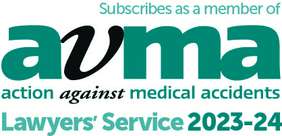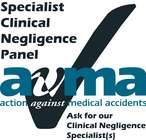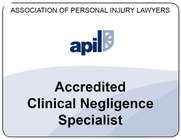Birth injury statistics

Birth injury claims
Most of the time, pregnancy and childbirth is straightforward. However, sometimes there are complications and there can be injury to the mother, the baby or both.
Sometimes these injuries are unavoidable, but every year there are a number of cases where injuries, which can have life-changing consequences, are caused by medical negligence.
If something happened to you, or your baby, you don't have to suffer in silence - it’s natural to want to understand what happened, and why. Our specialist birth injury claims solicitor can help you find a way forward.
We’ve all the expertise you need. We’ve advised many women on wide-ranging problems related to birth injuries, including:
- injuries to the baby – such as stillbirth, cerebral palsy, Erb’s palsy, hyperbilirunia, and broken bones
- injuries to the mother – such as pre-eclampsia, haemorrhages, perineal tears, uterine prolapse, faecal incontinence, complications with anaesthetics, and infections
- failed sterilisation
- disabled children – such as a failure to detect spina bifida or hydrocephalus, or misjudging the risk of Down’s syndrome.
If you or your baby has suffered from a birth injury and you are worried about the care you received, contact us today.
Our specialist birth injury claims solicitors understand what you’re going through, and we can help you get answers about your care. We’ll listen to your experiences, and help you find out what happened during your pregnancy and delivery.
The UK is one of the safest countries in the world to have a baby in. However, there are inherent risks associated with pregnancy and childbirth. Here, we look at the potential risks and benefits of different types of delivery.
Overall, the UK is a very safe place to have a baby. There were 696,271 live births in England and Wales in 2016 and the stillbirth rate is decreasing. Data shows that in 2016 the stillbirth rate decreased to 4.4 per 1,000 births (England and Wales - the lowest rate recorded since 1992.
However, research suggests that maternity care can be improved. Research shows that 921 babies suffered a serious birth injury in 2015. Many of those injuries were life-altering or, very sadly, resulted in the baby’s death. Of these:
- 119 babies suffered from intrapartum stillbirth (the baby died during labour)
- 147 babies died during the neonatal period (the baby died shortly after birth)
- 655 babies suffered a severe brain injury.
Pregnancy and childbirth can also put the mother at risk. In very rare cases, the mother can die during pregnancy and childbirth (called maternal death, or maternal mortality). In 2010-12 , the maternal death rate in the UK was 10 in every 100,000 maternities. These figures also include women who opted for a termination of pregnancy or suffered an ectopic pregnancy.
Different types of delivery are associated with different risks to the mother and baby. To view specific information about each type of delivery, please click below or continue reading:
- risks of birth injury during a home birth
- risk of birth injury at a birth centre or midwife led unit
- Risks of birth injury during a vaginal delivery
- Risks of birth injury during an elective or repeat caesarean section
- Emergency caesarean section
- Risks of birth injury during vaginal birth after caesarean section (VBAC)
Risks of birth injury during a home birth
Deciding where to have your baby is a very personal decision. It is your choice, and you don’t have to have your baby in hospital if you don’t want to. Some parents choose a home birth so that their baby is born in a relaxed, comfortable home environment. Home births might be an option if you want to avoid a medicalised labour.
Based on current research, the NHS reports that “as a whole, home births are as safe as ones in medical settings”. Serious complications occur in 4.3 out of every 1,000 births (whether in hospital, a birth centre or at home).
However, research suggests that in certain conditions a home birth may be more risky than a hospital delivery. In first pregnancies, a home birth almost doubles the risk of the baby suffering a birth injury (compared to delivery at a hospital or birth centre). A home birth can, in certain conditions, increase the risk of complications during delivery (up to a three times greater risk). This includes a broad range of complications – including very serious injuries such as brain injury to the baby, to treatable injuries including bone fractures. 45% of first time mothers who attempt a home birth are transferred to hospital, compared to 12% of women who have had a baby before.
Despite the relatively increased risks, the chances of suffering a serious complication during a home birth remain low. If you are considering a home birth, involve your midwife or GP early on. They are best placed to advise you, and they should ensure you are aware of the benefits and any potential risks of a home birth.
Risks of birth injury at a birth centre or midwifery unit
Birth centres (also called midwifery units) are different to hospitals. They’re run by midwives, and often have a more relaxed atmosphere compared to a hospital maternity unit. Some parents opt for a birth centre delivery because the unit has:
- friendly, welcoming atmosphere
- higher chance of being attended by a familiar midwife
- lower rate of medical intervention (less likely to have a forceps or ventouse delivery).
There are no specific risks linked to birth centres, but your midwife/doctor might recommend a hospital delivery instead if your pregnancy is considered ‘high risk’. You might have a high risk pregnancy if: you have a pre-existing medical condition, if you experience complications during pregnancy or if you had a complication during a previous delivery. Normally this is a precautionary measure to reduce the risk of harm to you or your baby. If there are complications during your labour (for example, if the baby is in distress and you need an emergency caesarean section) a hospital is equipped to deal with it.
Generally speaking, having a baby at a birth centre is very safe. They are reassuring, homely environments which can help to reduce the stress and anxiety around giving birth. If you would like to have your baby in a birth centre, talk to your midwife or GP and include this in your birth plan.
Risks of birth injury during a vaginal delivery
There are risks during any type of delivery, and vaginal deliveries are no exception. If you are planning a vaginal delivery, your midwife/doctor should explain the benefits as well as the potential risks.
9 out of 10 women suffer a perineal tear during a vaginal delivery. Unfortunately, some of these tears are serious (3rd or 4th degree tears) and are considered maternal birth injuries. About 3% of women suffer a serious tear which affects the muscles in the anus (back passage) and perineum (the area between the vagina and anus). Tears can damage the pelvic floor muscles, which control your bladder and bowel movements. Consequently, vaginal deliveries are associated with an increased risk of bowel and urinary incontinence (compared to a caesarean section). The symptoms of serious tears can last a long time, and be very difficult to cope with – affecting the mother’s career, relationships and day to day life. Research suggests that, compared to a caesarean section, women who have a vaginal delivery are 67% more likely to suffer urinary incontinence. The effects are also more likely to be long term, with a 275% increased risk of urinary incontinence 10 years’ after a vaginal birth (compared to a caesarean section).
Vaginal births can also be complicated by shoulder dystocia. Shoulder dystocia is when the baby’s shoulder becomes stuck behind the mother’s pelvic bone, with the head already delivered. It is a rare complication which affects in about 1 in every 150 births. It can cause Erb’s palsy or possibly brain injury to the baby.
You can read more about possible birth injuries to mothers, and their frequency, here.
Certain factors can increase the risk of injury during a vaginal birth – including your weight, age, medical history and whether you’ve had any children before. Your caregivers should tell you about the risks so that you can make an informed decision about the mode of delivery before you have your baby.
Risks of birth injury during an elective or repeat caesarean section
A quarter of babies in the UK are born through caesarean section. Most of these babies are born healthy, and the procedure is normally straightforward. However, a caesarean section is still major surgery. Any type of surgery has risks, though the chance of a serious problem are quite low. When caesarean sections go wrong, it can be extremely traumatic for babies and their parents.
If your pregnancy is considered ‘high risk’ or has been particularly difficult, your midwife/doctor might recommend a planned (or ‘elective’) caesarean. In certain situations, planned caesareans can help manage a high risk pregnancy and reduce the chance of mother or baby suffering serious harm. Your midwife/doctor should explain the potential risks and benefits of a planned caesarean, and answer any questions you might have. Planned caesarean sections are usually recommended if, on balance, it’s less risky to have a caesarean section than ‘spontaneous’ (natural) labour and a vaginal delivery. The reasons why your midwife/doctor may recommend a planned caesarean include: if you have a low-lying placenta, your baby is in the breech position or if you’ve previously had a caesarean section.
Complications following caesarean sections include:
- 3-4 in every 100 babies born by planned caesarean suffer from breathing problems (compared to 2-3 in every 100 babies born by vaginal delivery)
- there is a chance the mother might develop a blood clot in her lung (pulmonary embolism). Pulmonary embolisms after a caesarean section are very rare, but they can be life-threatening. 1 in 1,000 women who suffer a pulmonary embolism following a caesarean section die from the condition
- infections after a caesarean section are also fairly common. They normally take a few weeks to heal, but can be quite painful.
The above list is not exhaustive. There are additional risks for women who have had three or more caesarean sections, including:
- placenta accreta (retained placenta following baby’s birth)
- emergency hysterectomy (removal of the womb)
- damage to the bowel (which affects 1 in 1,000 women), bladder or ureter which can cause incontinence
- higher risk of stillbirth in future pregnancies (4 in 1,000 compared to 2 in 1,000 vaginal deliveries).
It usually takes longer to recover from a caesarean section than a vaginal birth. This is because a caesarean section is a major surgery, and your wound needs time to heal. Some mothers struggle to sit upright, or get around much just after their baby is born.
Emergency caesarean section
Your doctor might recommend an emergency caesarean section if there are complications during your labour. Situations where an emergency caesarean section might be necessary include:
- if your baby is distressed (normally indicated by changes in baby’s heart rate)
- your labour is particularly long or difficult, or you have a long second stage
- if your baby is in an awkward position or is particularly big
- the mother’s well-being is at risk
- a vaginal delivery is not possible without endangering the health of the baby or mother.
13% of babies are born by emergency caesarean section. It can be a frightening, and even traumatic situation for parents. Unfortunately, some women end up not having the birth experience they’d planned due to unforeseen complications during labour which necessitate an emergency caesarean. It can be a difficult experience for both partners, and the physical and emotional recovery can be difficult.
You can read more about the psychological effects of childbirth here.
Risks of birth injury during vaginal birth after caesarean section (VBAC)
Many women choose a vaginal birth after a caesarean section in a previous pregnancy (VBAC), for example, if they wish to avoid another caesarean.
VBAC deliveries have a 72-75% success rate (this is increased to 85-90% if you’ve had a vaginal delivery before). Many women achieve their goal of a successful vaginal delivery, and a successful VBAC may be the safest delivery option. However, VBAC deliveries are associated with the following risks:
- 25% of women who attempt a VBAC will be unsuccessful and require an emergency caesarean section to deliver their baby – a procedure which can be traumatic and frightening
- women who attempt a VBAC have a 1% higher chance of requiring a blood transfusion or suffering a uterine infection (compared to a repeat caesarean section)
- 0.5% (1 in 200) women suffer uterine rupture during VBAC. This is where the scar of a previous caesarean section weakens and splits, which can be life-threatening
- 0.2% (approximately 2 out of every 1,000) of babies born by VBAC suffer brain damage or, sadly, die during delivery. This risk is comparable to the risks of a first-time labour. The risks of brain damage are lower during an elective repeat caesarean section (0.1% or 1 in every 1,000).
The risks increase if the mother attempts a VBAC but is unsuccessful. Your care provider should make you aware of this.
If you have previously had a caesarean section, your midwife and doctor should explain the risks and the benefits of a VBAC compared to a planned caesarean section. They should also explain the risks of multiple caesarean sections and how this could affect any subsequent pregnancies.
Disclaimer
All content is provided for general information only, and should not be treated as a substitute for the medical advice of your own doctor, any other health care professional or for the legal advice of your own lawyer. Tees is not responsible or liable for any diagnosis made by a user based on the content of this site. Tees is not liable for the contents of any external internet sites listed, nor does it endorse any service mentioned or advised on any of the sites. Always consult your own GP if you're in any way concerned about your health and your lawyer for legal advice.
Call for a FREE initial consultation on 0800 013 1165
Tees is here to help
We have many specialist lawyers who are based in:
Cambridgeshire: Cambridge
Essex: Brentwood, Chelmsford, and Saffron Walden
Hertfordshire: Bishop's Stortford and Royston
But we can help you wherever you are in England and Wales.
Chat to the Author, Janine Collier
Executive Partner, Medical Negligence, Cambridge office
Meet Janine
- Areas of expertise
- Accreditations
- Testimonials
Legal 500 UK 2023
'Janine Collier has an amazing reputation and quite rightly, she very quickly spotted something that wasn’t the main focus of the case but is able to zoom out and look at everything that’s going on and spot things others wouldn’t spot. You can tell she really cares and is a very dedicated person who just wants to help. The team are all caring and efficient'
A
Cambridge
'A heartfelt thank you for all you have done in preparation for and during the settlement meeting, as well as for your unfailing support along the way, in and out of hours. It is undoubtedly due to your high professionalism if the outcome today has exceeded all expectations; it will be a huge help for us going forward and we will be forever grateful'
Chambers & Partners 2022
Cambridge
'Janine Collier is renowned for her handling of delay in diagnosis, obstetric injury and surgical negligence claims. She is at the top of her game and knows clinical negligence inside and out'
Susan Hickman
Cambridge
'We consider ourselves fortunate to have been recommended to Tees by the solicitor we initially approached. We did not realise it until the case was well established that the level of professional care we were receiving was exceptional and that the experience of the individuals and the contacts they have to assist in a very complex case was the best available. We are grateful that we received a satisfactory settlement as a result of their efforts under difficult circumstances and dealing with defendants that were obstructive and disorganised. By far the greatest benefit for us however is the fact that the victim, with assistance from highly skilled experts that we would not have known about otherwise, learned to walk short distances when all other medical opinion did not consider this possible. This was their greatest achievement which is well beyond the service we expected'
Legal 500 UK 2021
"Janine Collier, head of department, is a perspicacious and very able lawyer, certainly one of the best in the region and beyond, who believes in her team and in the work she does. A genuinely nice person who sees it as her clients’ right and her duty to achieve the best possible outcome for them. Janine delivers this time after time. She is an extremely intelligent and intuitive lawyer who has a genuine understanding of the difficulties and fears clients experience when living with an avoidable injury."
Legal 500 UK 2021
"Janine Collier is a really good solicitor – she really understands the medicine in clin neg cases and works well with the team, the clients and the experts to get excellent results in difficult cases."
Legal 500 UK 2021
"Janine Collier is exceptionally good at analysis, organisation and strategy."
Legal 500 UK 2021
"Janine Collier is a really good solicitor, she really understands the medicine in clinical negligence cases and works well with the team, the clients and the experts to get excellent results in difficult cases."
Legal 500 2021
"Janine Collier shows dedication to ensuring access to the highest level of experts on medical negligence cases. There is excellent consistent communication with experts throughout a lengthy case, creating a supportive working atmosphere and ensuring long-term engagement of expert. She has a very intelligent and insightful approach to learning from experts, enabling sharing of detailed specialist information and findings with confidence, and she is excellent in multi-professional meetings with solicitors and barristers, enhancing communication in exceptionally complex cases; very high level of sensitivity demonstrated towards the needs of client throughout the case, consistently focusing on the multifactorial needs of the client, over and above the monetary compensation."
Legal 500 UK 2021
"Janine Collier has been amazing to work with. She is always quick to respond to queries, always takes time to make sure we fully understand the process and supports us to make decisions, i.e. switching from Legal Aid to no-win no-fee, with well reasoned and researched information to support us."
Legal 500 UK 2021
‘It has always been a rewarding experience working with Janine Collier and I would commend her very highly to lead on medical negligence cases.‘
The Fisher family
Janine works with empathy, understanding and compassion. She handled our mother's inquest with skill and sensitivity and guided us expertly. She kept us informed continually via email and multiple meetings and phone calls. Janine completely took the sting and the stress out of our case.







